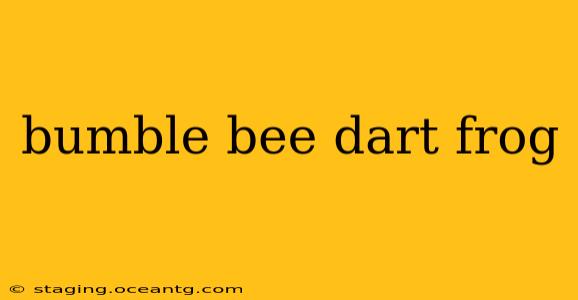The bumble bee dart frog ( Dendrobates leucomelas) is a captivating amphibian, instantly recognizable for its striking yellow and black coloration, reminiscent of its namesake. These small but fascinating creatures are a popular choice among both experienced and aspiring herpetologists, but understanding their specific needs is crucial for responsible care. This comprehensive guide delves into the intricacies of this vibrant species, addressing frequently asked questions and offering insights into their captivating world.
What makes the bumble bee dart frog unique?
The bumble bee dart frog’s striking appearance is its most defining characteristic. The intense yellow and black markings serve as aposematism – a warning to potential predators of its toxicity. Unlike many other dart frogs, the Dendrobates leucomelas exhibits significant variation in its coloration, ranging from almost entirely black to predominantly yellow, with the pattern and intensity varying geographically. This variation makes each frog a unique individual. Beyond their aesthetics, they are relatively hardy and adaptable dart frogs, making them a popular choice for beginners, although responsible ownership still requires diligent attention to detail.
What do bumble bee dart frogs eat?
In the wild, bumble bee dart frogs primarily consume ants, termites, and other small invertebrates. In captivity, providing a varied diet of cultured fruit flies ( Drosophila melanogaster and Drosophila hydei), springtails, and pinhead crickets is essential for their health and well-being. Dusting the insects with a calcium and vitamin D3 supplement is crucial for preventing metabolic bone disease. The frequency of feeding depends on the frog's age and size; juveniles typically require more frequent feedings than adults.
Are bumble bee dart frogs poisonous?
While bumble bee dart frogs are indeed poisonous, the level of toxicity varies depending on their diet. In the wild, their toxicity is derived from the insects they consume, particularly ants and mites. Captive-bred bumble bee dart frogs typically have significantly reduced toxicity, although handling should still be avoided to prevent potential irritation to the skin and eyes. Never lick or ingest these frogs.
How big do bumble bee dart frogs get?
Adult bumble bee dart frogs usually reach a size of approximately 1.5 to 2 inches (3.8 to 5 cm) in length. Their relatively small size contributes to their popularity as pets, requiring less space than larger amphibian species.
How long do bumble bee dart frogs live?
With proper care, bumble bee dart frogs can live for 5 to 15 years or more in captivity. Providing a suitable environment, a nutritious diet, and maintaining a stress-free environment are all crucial factors influencing their lifespan.
Where do bumble bee dart frogs live?
Bumble bee dart frogs are native to northern South America, inhabiting regions of Venezuela, Brazil, Guyana, and possibly Colombia. They prefer humid, tropical environments with leaf litter and plenty of cover, such as rainforests. Their habitat is crucial in understanding their needs in captivity.
How do I care for a bumble bee dart frog?
Creating a suitable habitat is vital for the well-being of your bumble bee dart frog. A vivarium with adequate ventilation, humidity (70-80%), and temperature (75-80°F or 24-27°C) is essential. Live plants, leaf litter, and hiding places are necessary to mimic their natural environment and reduce stress. Regular cleaning and misting to maintain humidity levels are vital parts of their care.
What are the signs of a healthy bumble bee dart frog?
A healthy bumble bee dart frog will be active, have bright coloration, and exhibit a good appetite. Any signs of lethargy, weight loss, or changes in skin coloration should prompt immediate attention from a veterinarian specializing in exotic animals.
Are bumble bee dart frogs good pets for beginners?
While relatively hardy compared to some dart frog species, keeping bumble bee dart frogs requires commitment and thorough research. Understanding their specific needs and being prepared to provide a suitable environment is crucial for their well-being. Beginners should thoroughly research the commitment involved before taking on this responsibility.
This guide provides a comprehensive overview of the bumble bee dart frog. Remember, responsible ownership involves continuous learning and a dedication to providing the best possible care for these fascinating creatures. Further research and consultation with experienced keepers are recommended before acquiring these beautiful amphibians.
